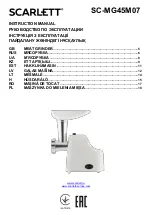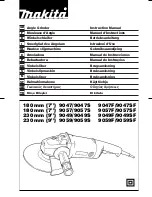
RG25DH Operation • Service • Maintenance • Parts Manual
800.392.2686
45
Troubleshooting
Troubleshooting
The information on this page has been provided to help
understand the internal operation. Do not
use this information to attempt any internal repairs.
TecumsehPower's current policy on hydrostatic
transaxles that have internal failures is to replace
the complete unit. This has not changed. However,
TecumsehPower would like to provide a failure
checklist to assist in making an accurate evaluation
of the complete tractor to eliminate any unnecessary
replacements. Here is a list of items to check and
corrective actions to take.
To properly test the unit for power loss.
1. Allow the unit to cool before trying the following
steps.
2. Put the shift lever in a position that is 1/2 of the
travel distance from neutral to forward.
3. Place the tractor on a 17
o
grade.
4. Drive the tractor up the grade (without the mower
deck engaged). The loss of power experienced
should be approximately 20%. This is considered
normal. If the loss of power is approximately 50%,
this would be considered excessive.
5. Bring the unit to neutral, shift into forward and note
the response. Care should be taken to move the
lever slowly to avoid an abrupt wheel lift.
To determine if the problem is with the hydro unit, all
external problem possibilities must be eliminated. Here
are some potential problem areas.
1.
Overheating:
Heat can cause a breakdown in the
viscosity of the oil which reduces the pressure used
to move the motor. Remove any grass, debris, or
dirt buildup on the transaxle cover and / or between
the cooling fins and fan. Buildup of material will
reduce the cooling efficiency.
2.
Belt slippage:
A belt that is worn, stretched, or
the wrong belt (too large or wide) can cause belt
slippage. This condition may have the same loss of
power symptom as overheating. Typically, the unit
which has a slipping belt will exhibit a pulsating type
motion of the mower. This can be verified visually
by watching the belt and pulley relationship. If the
belt is slipping, the belt will chatter or jump on the
pulley. If the belt is good, a smooth rotation will be
seen. Replace the belt and inspect the pulley for
damage.
3.
Leakage:
The VST and 1800 Series have two oil
reservoirs which can be checked for diagnostic
purposes. The first is the pump and motor expansion
bellows. With a small diameter blunt or round nose
probe, check the bellows depth through the center
vent hole. Proper depth from the edge of that hole
is 3-1/4 - 3-1/2 inches (8.25 - 8.9 cm).
The second chamber is for the output gears
including the differential. FIRST make sure the
tractor is level, then remove the drain/fill plug.
NOTE: Some units that do not have differential
disconnect will have two plugs. We recommend
using only the primary plug. With a small pocket
rule insert until you touch bottom of case. You
can then remove it and check for 1/4 - 3/8 inches
(6.5 - 9.5 mm) contact, this is full at its 8 oz.
capacity.
4.
Low ground speed:
If the linkage is not
synchronized to absolute neutral, or the shift lever
is not properly fastened to the tapered control shaft,
full forward travel may not be achieved. This may
cause a false reading and be misdiagnosed as a
low power condition. This also could be caused by
the brake not releasing.
To determine absolute neutral, the hole in the
tapered control shaft must face straight up and
down, at this point make sure the O.E.M. linkage is
in neutral. To properly fasten the control lever to the
shaft, torque the nut to 25-35 ft. lbs. (34 - 48.3 Nm)
of torque with the shaft and the lever in neutral.
When attaching the shifter arm to the shaft you
must prevent any rotation during torquing. This can
be done by placing a long 5/16" bolt in the hole of
the shaft. Hold the bolt until the tapers are locked
and the nut torque is correct.
To make sure that the brake is not binding, drive the
unit up a slight grade. Position the speed control
lever into neutral. The unit should coast backwards.
If the unit does not coast back slowly, the brake is
not released from the brake disk. Adjust the brake
linkage to release the brake completely when the
foot pedal is released.
5.
Hard to shift:
Typically hard to shift symptoms are
not caused by the hydrostatic unit. The shift arm
should move with relative ease. Approximately 40-
50 in. lbs. (4.48 - 5.6 Nm) at the transaxle for foot
pedal units or 150-200 in. lbs. (16.8 -22.4 Nm) for
hand operated units. This varies depending on the
type of linkage. Binding may occur in the linkage
connections due to rust or moisture. Lubricating
these connections and checking for bent or
damaged parts should resolve hard shifting.
Summary of Contents for RG25HD
Page 48: ...RG25DH Operation Service Maintenance Parts Manual 48 Troubleshooting ...
Page 49: ...RG25DH Operation Service Maintenance Parts Manual 800 392 2686 49 Troubleshooting ...
Page 50: ...RG25DH Operation Service Maintenance Parts Manual 50 Troubleshooting ...
Page 51: ...RG25DH Operation Service Maintenance Parts Manual 800 392 2686 51 Troubleshooting ...
Page 52: ...RG25DH Operation Service Maintenance Parts Manual 52 Troubleshooting ...
Page 53: ...RG25DH Operation Service Maintenance Parts Manual 800 392 2686 53 Troubleshooting ...
Page 54: ...RG25DH Operation Service Maintenance Parts Manual 54 Troubleshooting ...
Page 55: ...RG25DH Operation Service Maintenance Parts Manual 800 392 2686 55 Troubleshooting ...
Page 56: ...RG25DH Operation Service Maintenance Parts Manual 56 Troubleshooting ...
Page 57: ...RG25DH Operation Service Maintenance Parts Manual 800 392 2686 57 Troubleshooting ...
Page 66: ...RG25DH Operation Service Maintenance Parts Manual 66 Hydraulic Drive Assembly ...
















































